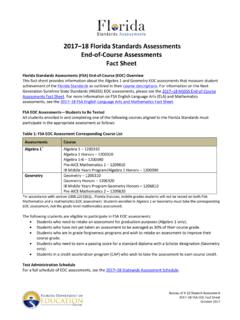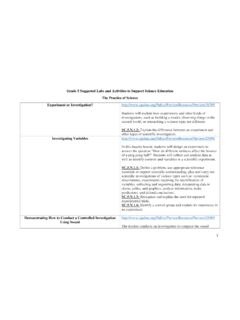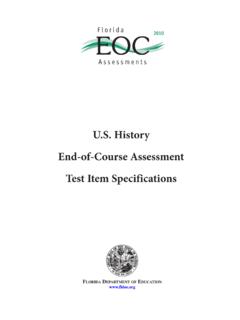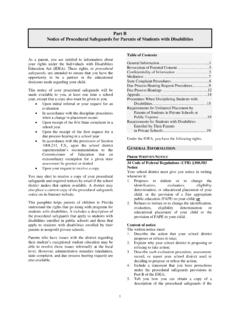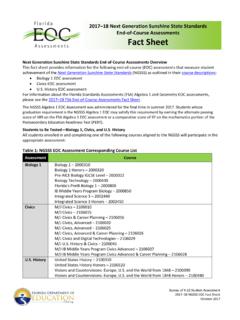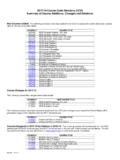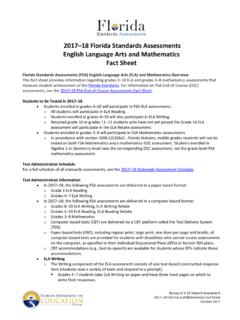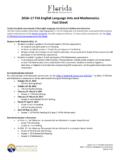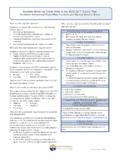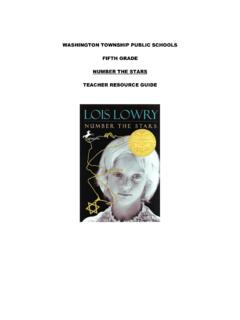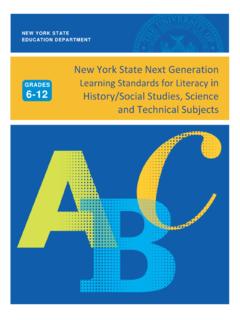Transcription of B.E.S.T. ELA Standards - fldoe.org
1 ELA StandardsJust Read, Florida! Standards were created by Florida educators for Florida students. Stackable Benchmarks ELA Expectations Benchmark Clarifications Literary Time Periods Booklist (ELA) Civics Booklist Rhetoric (starting in 6th) Reasoning Reading and Writing Connection Comprehensive SchemeCreative MapCreative of the ELA Premises of Florida s ELA Standards : english language arts is not a discrete set of skills, but a rich discipline with meaningful, significant content, the knowledge of which helps all students actively and fully participate in our society. The Standards are clear and concise so they are easily understood by every stakeholder. The texts students read are meaningful and thought-provoking, preparing them to be informed, civic-minded members of their community.
2 Standards should not stand alone as a separate focus for instruction, but should be combined purposefully. 7 of Standards for ELA and Clarifications : Compare two or more themes and their development throughout a literary Clarifications:Clarification 1: For the purposes of this benchmark, theme is not a one- or two-word topic, but a complete thought that communicates the author s 2:Students should continue to work with the concept of universal themes, although mastery isn t expected until 9th grade . A universal theme is an idea that applies to anyone, anywhere, regardless of cultural differences. Examples include but are not limited to an individual s or a community s confrontation with nature; an individual s struggle toward understanding, awareness, and/or spiritual enlightenment; the tension between the ideal and the real; the conflict between human beings and advancements in technology/science; the impact of the past on the present; the inevitability of fate; the struggle for equality; and the loss of & Unpacking 8 of Standards for ELA Benchmarks for the Standards are mastery goals that students are expected to attain by the end of the year.
3 To build mastery, students will continue to review and apply earlier grade -level benchmarks and expectations. If skills are not mastered, students will be given instruction and practice opportunities to address skill gaps from previous grades. 1 is Key! A rising tide lifts all boats. Foundational Standards Print Concepts Phonological Awareness Phonics and Word Analysis FluencyCreative CommonsScience of Foundational Standards 24 Phonological Awareness Phonics and Word Analysis Encoding Fluency*Secondary foundational Standards will only appear in elective remedial reading course INSTRUCTION MATTERS-Florida s Standards : english language arts (page 6)In the early grades, the Standards emphasize explicit, systematic phonics instruction as the foundation of literacy.
4 Decoding and fluency are essential to creating proficient readers. Readers who have strong decoding skills can figure out unfamiliar words so quickly that the process requires no conscious effort, says Dr. Holly Lane, Director, University of Florida Literacy Institute. When decoding is effortless, a reader s limited working memory is freed up so the reader can focus on s Standards : english language arts (page 6) E: Reading FoundationsFlorida s Standards : english language arts (pages 206-211)Phonological awareness, alphabetic skills, and language skills are the best predictors of early reading s Standards : english language arts (page 206) : Sarah, Plain and Tall is a text? For the purposes of text within the Standards , the full breadth of the term text is intended.
5 The Standards are meant to prepare students to interpret a variety of texts in a variety of formats. In planning instruction, make sure that students are exposed to a diverse selection of quality texts. ELA are literary periods important?Restore Context:Knowing the time frame of when the text was written gives us insight on why an author included certain content, his/her perspective, and social issues during that time. We encounter works from the time frame we are reading in rather then the time frame the work was PeriodsGrades PeriodsGrades 9-12 Grades 6-12 (Focus for 6-8) PeriodsGrades 6-12 (Focus for 6-8) of Literary PeriodsComparative Reading : Analyze the influence of classic literature on contemporary world texts. Benchmark Clarifications: Clarification 1:Classic literature for this benchmark should be drawn from and representative of the following periods: Classical Period (1200 BCE 455 CE) Medieval Period (455 CE 1485 CE) Renaissance Period (1300 1600) Restoration and 18th Century (1660 1790) British Literature Colonial and Early National Period (1600 1830) American Literature Romantic Period (1790 1870) Realism and Naturalism Period (1870 1930) Modernist Period (1910 1945) Clarification 2:Contemporary world texts are those written after World War II that, through quality of form and expression, convey ideas of permanent or universal interest.
6 The elementary grades, students should be exposed to a variety of literature from different time periods. Students will not be expected to know the characteristics of the time periods. Creative Infused at Every grade LevelK Brown Bear, Brown Bear, Curious George, Hop on Pop, Corduroy1 Clifford, Three Little Pigs, Velveteen Rabbit, Madeline2 Winnie the Pooh, The Gingerbread Man, Seven Blind Mice 3 Charlotte s Web, The Boxcar Children, Pippi Longstocking4 Johnny Tremain, Little House on the Prairie, Homer Price5 Paul Revere s Ride , Call it Courage, Island of the Blue Infused at Every grade Level6 Hatchet, Treasure Island, Little Women, The Hiding Place7 The Yearling, The Prince and the Pauper, Old Yeller, Sonnet 18 8 The Diary of Anne Frank, The Call of the Wild, Rip Van Winkle9 The Iliad, Animal Farm, Romeo and Juliet, Beowulf, 198410 A Tale of Two Cities, Lord of the Flies, Common Sense.
7 Macbeth11 Julius Caesar, Night, Jane Eyre, O Captain, My Captain 12 Pride and Prejudice, Don Quixote, King Lear, Utopia, Texts by StandardCivic Literacy Reading and 50%Informational Te x tCreative full text should be used where would be permissible where there was a sense of completeness: For literary texts, there should be a complete story arc. For informational texts, the text should be able to stand alone with minimal scaffolding.*Texts can be included as text sets. go first!Change is & Implementation SupportsLet it Happen: Minimal Supports Disseminate Information Accountable for outcomes Help it Happen Some provision of materials, training resources, and websites are provided Targeted support for using information ( , limited training, webinars) Accountable for outcomes Make it Happen Full provision of materials, training resources, and websites are provided Intensive support for system change and using information: Training, Coaching, and Data Systems Accountable for outcomes Implementation science refers to the methods or techniques used to enhance the adoption, implementation, and sustainability of an intervention(Powell et al.)
8 , 2015)Implement = UseChange ProcessActive Implementation Fixsen, Blase, Metz, & Van Dyke (2015) Reflect on the work of your previous Standards roll-out .. Answer the questions: Were all three factors from formula present? If no, what was missing If yes, what was a key factor of action steps can my district take to ensue the success of the ELA roll out?Creative SweetDeputy DirectorJust Read.
